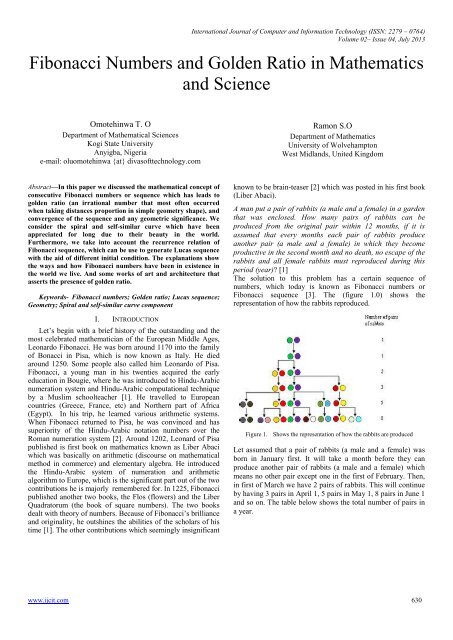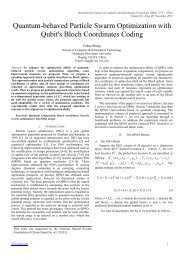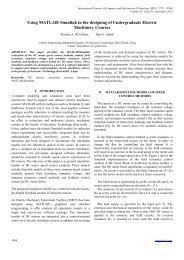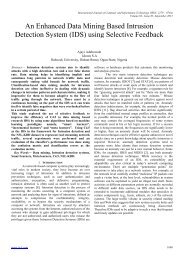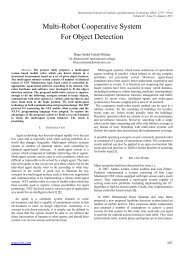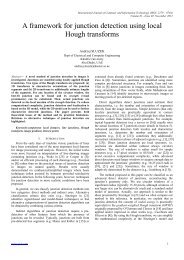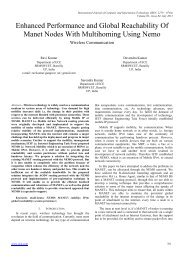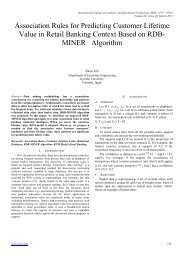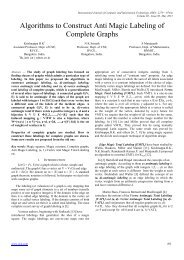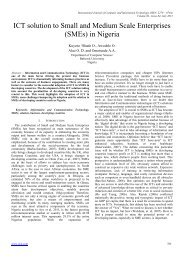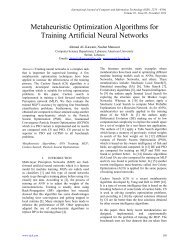Fibonacci Numbers and Golden Ratio in Mathematics and Science
Fibonacci Numbers and Golden Ratio in Mathematics and Science
Fibonacci Numbers and Golden Ratio in Mathematics and Science
Create successful ePaper yourself
Turn your PDF publications into a flip-book with our unique Google optimized e-Paper software.
International Journal of Computer <strong>and</strong> Information Technology (ISSN: 2279 – 0764)<br />
Volume 02– Issue 04, July 2013<br />
<strong>Fibonacci</strong> <strong>Numbers</strong> <strong>and</strong> <strong>Golden</strong> <strong>Ratio</strong> <strong>in</strong> <strong>Mathematics</strong><br />
<strong>and</strong> <strong>Science</strong><br />
Omoteh<strong>in</strong>wa T. O<br />
Department of Mathematical <strong>Science</strong>s<br />
Kogi State University<br />
Anyigba, Nigeria<br />
e-mail: oluomoteh<strong>in</strong>wa {at} divasofttechnology.com<br />
Ramon S.O<br />
Department of <strong>Mathematics</strong><br />
University of Wolvehampton<br />
West Midl<strong>and</strong>s, United K<strong>in</strong>gdom<br />
Abstract—In this paper we discussed the mathematical concept of<br />
consecutive <strong>Fibonacci</strong> numbers or sequence which has leads to<br />
golden ratio (an irrational number that most often occurred<br />
when tak<strong>in</strong>g distances proportion <strong>in</strong> simple geometry shape), <strong>and</strong><br />
convergence of the sequence <strong>and</strong> any geometric significance. We<br />
consider the spiral <strong>and</strong> self-similar curve which have been<br />
appreciated for long due to their beauty <strong>in</strong> the world.<br />
Furthermore, we take <strong>in</strong>to account the recurrence relation of<br />
<strong>Fibonacci</strong> sequence, which can be use to generate Lucas sequence<br />
with the aid of different <strong>in</strong>itial condition. The explanations show<br />
the ways <strong>and</strong> how <strong>Fibonacci</strong> numbers have been <strong>in</strong> existence <strong>in</strong><br />
the world we live. And some works of art <strong>and</strong> architecture that<br />
asserts the presence of golden ratio.<br />
Keywords- <strong>Fibonacci</strong> numbers; <strong>Golden</strong> ratio; Lucas sequence;<br />
Geometry; Spiral <strong>and</strong> self-similar curve component<br />
I. INTRODUCTION<br />
Let’s beg<strong>in</strong> with a brief history of the outst<strong>and</strong><strong>in</strong>g <strong>and</strong> the<br />
most celebrated mathematician of the European Middle Ages,<br />
Leonardo <strong>Fibonacci</strong>. He was born around 1170 <strong>in</strong>to the family<br />
of Bonacci <strong>in</strong> Pisa, which is now known as Italy. He died<br />
around 1250. Some people also called him Leonardo of Pisa.<br />
<strong>Fibonacci</strong>, a young man <strong>in</strong> his twenties acquired the early<br />
education <strong>in</strong> Bougie, where he was <strong>in</strong>troduced to H<strong>in</strong>du-Arabic<br />
numeration system <strong>and</strong> H<strong>in</strong>du-Arabic computational technique<br />
by a Muslim schoolteacher [1]. He travelled to European<br />
countries (Greece, France, etc) <strong>and</strong> Northern part of Africa<br />
(Egypt). In his trip, he learned various arithmetic systems.<br />
When <strong>Fibonacci</strong> returned to Pisa, he was conv<strong>in</strong>ced <strong>and</strong> has<br />
superiority of the H<strong>in</strong>du-Arabic notation numbers over the<br />
Roman numeration system [2]. Around 1202, Leonard of Pisa<br />
published is first book on mathematics known as Liber Abaci<br />
which was basically on arithmetic (discourse on mathematical<br />
method <strong>in</strong> commerce) <strong>and</strong> elementary algebra. He <strong>in</strong>troduced<br />
the H<strong>in</strong>du-Arabic system of numeration <strong>and</strong> arithmetic<br />
algorithm to Europe, which is the significant part out of the two<br />
contributions he is majorly remembered for. In 1225, <strong>Fibonacci</strong><br />
published another two books, the Flos (flowers) <strong>and</strong> the Liber<br />
Quadratorum (the book of square numbers). The two books<br />
dealt with theory of numbers. Because of <strong>Fibonacci</strong>’s brilliance<br />
<strong>and</strong> orig<strong>in</strong>ality, he outsh<strong>in</strong>es the abilities of the scholars of his<br />
time [1]. The other contributions which seem<strong>in</strong>gly <strong>in</strong>significant<br />
known to be bra<strong>in</strong>-teaser [2] which was posted <strong>in</strong> his first book<br />
(Liber Abaci).<br />
A man put a pair of rabbits (a male <strong>and</strong> a female) <strong>in</strong> a garden<br />
that was enclosed. How many pairs of rabbits can be<br />
produced from the orig<strong>in</strong>al pair with<strong>in</strong> 12 months, if it is<br />
assumed that every months each pair of rabbits produce<br />
another pair (a male <strong>and</strong> a female) <strong>in</strong> which they become<br />
productive <strong>in</strong> the second month <strong>and</strong> no death, no escape of the<br />
rabbits <strong>and</strong> all female rabbits must reproduced dur<strong>in</strong>g this<br />
period (year)? [1]<br />
The solution to this problem has a certa<strong>in</strong> sequence of<br />
numbers, which today is known as <strong>Fibonacci</strong> numbers or<br />
<strong>Fibonacci</strong> sequence [3]. The (figure 1.0) shows the<br />
representation of how the rabbits reproduced.<br />
Figure 1. Shows the representation of how the rabbits are produced<br />
Let assumed that a pair of rabbits (a male <strong>and</strong> a female) was<br />
born <strong>in</strong> January first. It will take a month before they can<br />
produce another pair of rabbits (a male <strong>and</strong> a female) which<br />
means no other pair except one <strong>in</strong> the first of February. Then,<br />
<strong>in</strong> first of March we have 2 pairs of rabbits. This will cont<strong>in</strong>ue<br />
by hav<strong>in</strong>g 3 pairs <strong>in</strong> April 1, 5 pairs <strong>in</strong> May 1, 8 pairs <strong>in</strong> June 1<br />
<strong>and</strong> so on. The table below shows the total number of pairs <strong>in</strong><br />
a year.<br />
www.ijcit.com 630
International Journal of Computer <strong>and</strong> Information Technology (ISSN: 2279 – 0764)<br />
Volume 02– Issue 04, July 2013<br />
TABLE I.<br />
SHOWS THE TOTAL NUMBER OF PAIRS IN A YEAR<br />
Month Baby Rabbit Mature Rabbit Total<br />
January 1 1 0 1<br />
February 1 0 1 1<br />
March 1 1 1 2<br />
April 1 1 2 3<br />
May 1 2 3 5<br />
June 1 3 5 8<br />
July 1 5 8 13<br />
August 1 8 13 21<br />
September 1 13 21 34<br />
October 1 21 34 55<br />
November 1 34 55 89<br />
December 1 55 89 144<br />
pr<strong>in</strong>ciples <strong>in</strong> all his sculptures [9]. <strong>Golden</strong> ratio has unique<br />
mathematical properties [6]. One of the properties is the<br />
concept that was orig<strong>in</strong>ated <strong>in</strong> plane geometry, division of a<br />
l<strong>in</strong>e segment <strong>in</strong>to two segments.<br />
If we can divide a l<strong>in</strong>e <strong>in</strong> such a way that the ratio of the whole<br />
length to the length of the longer segment happen to be equal to<br />
the ratio of the length of the longer segment to the length of the<br />
shorter segment, then we can say the ratio is golden ratio [6].<br />
Fig. 2 below shows the division of a whole length 1 <strong>in</strong>to two<br />
segments<br />
From TABLE I. above, the last column give 1, 1, 2, 3, 5, 8, 13,<br />
21, 34 . . . what we know as <strong>Fibonacci</strong> numbers, which was<br />
named by a French mathematician Francois-Edouard- Anotole-<br />
Lucas around 1876. And we have 144 pairs of rabbits <strong>in</strong> a year.<br />
<strong>Fibonacci</strong> numbers has been one of the most <strong>in</strong>terest<strong>in</strong>g<br />
number sequences that will be ever written down. The<br />
<strong>Fibonacci</strong> series is unique <strong>in</strong> such a way that for every two odd<br />
numbers the next is an even number. Also, the modern<br />
scientists <strong>and</strong> physicists commonly apply the recursive series<br />
of <strong>Fibonacci</strong> sequence [4]. This sequence has gone beyond a<br />
simple arithmetic <strong>in</strong> the branches of mathematics due to the<br />
fact that it was surpris<strong>in</strong>gly rediscovered <strong>in</strong> variety of forms.<br />
<strong>Fibonacci</strong> numbers has a fasc<strong>in</strong>at<strong>in</strong>g <strong>and</strong> unique property <strong>in</strong> the<br />
sense that, for all <strong>Fibonacci</strong> numbers is the sum of the two<br />
immediately preced<strong>in</strong>g <strong>Fibonacci</strong> numbers except the first two<br />
numbers [1]. Base on its methodological development has led<br />
to a great application <strong>in</strong> mathematics <strong>and</strong> computer science [2].<br />
The importance of the sequence gave course for an<br />
organization of mathematicians to form <strong>Fibonacci</strong> Association<br />
that used to publish scholarly journal, <strong>Fibonacci</strong> Quarterly [1]<br />
<strong>and</strong> [2]<br />
<strong>Golden</strong> <strong>Ratio</strong><br />
The irrational number, golden ratio [5] which is also known as<br />
golden section by the ancient Greeks [1], golden proportion,<br />
mean ratio, div<strong>in</strong>e proportion, golden mean or golden number<br />
[6], is widely used <strong>in</strong> modern sciences particularly <strong>in</strong><br />
theoretical physics [7]. The golden ratio has many<br />
properties <strong>in</strong> which people are eager to know. It is a number<br />
that is equal to the reciprocal of its own with the addition of 1:<br />
= + 1 [8]. Likewise, the ratio of any two consecutive<br />
<strong>Fibonacci</strong> numbers converges to give approximates of 1.618,<br />
or its <strong>in</strong>verse, 0.618. This shows the relationship between<br />
<strong>Fibonacci</strong> numbers <strong>and</strong> golden ratio. This <strong>Golden</strong> ratio had<br />
been used by Egyptians <strong>in</strong> the construction of their great<br />
pyramids. It is denoted by Greek letter called phi (Φ, capital<br />
letter or , small letter) but will be used <strong>in</strong> this context. The<br />
letter was given name phi by a mathematician from<br />
America, Mark Barr because it is the first letter <strong>in</strong> Greek<br />
alphabets <strong>in</strong> the name of Phidias, the greatest sculptor of<br />
Greek [1], that widely used golden section pr<strong>in</strong>ciples <strong>in</strong> all his<br />
sculptures [9]. <strong>Golden</strong> ratio has unique mathematical<br />
Figure 2.<br />
This gives mean ratio if = which satisfies the quadratic<br />
equation = 0 Thus, But we are<br />
<strong>in</strong>terested <strong>in</strong> the positive root, s<strong>in</strong>ce lengths cannot be negative.<br />
So,<br />
Hence, the desire ratio is<br />
II.<br />
0.61803398875…<br />
= = 1.61803…<br />
FIBONACCI NUMBERS AND NATURE<br />
The <strong>Fibonacci</strong> numbers had occurred <strong>in</strong> nature through the<br />
pattern of the petals on flowers, the arrangement of leaves <strong>in</strong><br />
the stem of a plant, the p<strong>in</strong>eapples scales or the p<strong>in</strong>econes<br />
bracts. <strong>Fibonacci</strong> sequence can also be figure out <strong>in</strong> the part<br />
human body (h<strong>and</strong>s). Different answers will be given if we ask<br />
ourselves “why does the arrangement occur”. For the<br />
arrangement of leaves, it might be for the space maximization<br />
for each leaf or for the average amount of sunlight fall<strong>in</strong>g on<br />
each leaf.<br />
A. <strong>Fibonacci</strong> <strong>Numbers</strong> <strong>in</strong> Plants<br />
There is occurrence of <strong>Fibonacci</strong> numbers <strong>in</strong> the growth of<br />
branches <strong>and</strong> leaves of some plants. Look<strong>in</strong>g at the (figures 3-<br />
5) which show the k<strong>in</strong>d of design that provide the best physical<br />
accommodation for the number of branches <strong>and</strong> leaves while<br />
sunlight exposure is be<strong>in</strong>g maximize [10].<br />
Figure 3 Figure 4 Figure 5<br />
Source: http:// britton.disted.camosun.bc.ca/fibslide/jbfibslide.htm<br />
www.ijcit.com 631
The leaves on the stem of a plant get optimum exposure to<br />
sunlight, when they grow or develop <strong>in</strong> alternat<strong>in</strong>g or zigzags<br />
manner which form a k<strong>in</strong>d of spiral pattern.<br />
International Journal of Computer <strong>and</strong> Information Technology (ISSN: 2279 – 0764)<br />
Volume 02– Issue 04, July 2013<br />
Figure 9.<br />
Source: http:// britton.disted.camosun.bc.ca/fibslide/jbfibslide.htm<br />
Figure 6.<br />
Source: http:// britton.disted.camosun.bc.ca/fibslide/jbfibslide.htm<br />
From Fig. 6, firstly, let our attention be on the leaf at the<br />
bottom of the stem <strong>in</strong> which there is a s<strong>in</strong>gle leaf at any po<strong>in</strong>t<br />
<strong>and</strong> the leaf to be zero (0). Count<strong>in</strong>g the leaves upward the<br />
stem until we reach the one <strong>in</strong> which is directly above the<br />
start<strong>in</strong>g one, zero. The number we get, a term of the <strong>Fibonacci</strong><br />
numbers is eight (8). And if we count the number of times we<br />
revolve around the stem, also a term of the <strong>Fibonacci</strong> numbers<br />
is five (5) [11].<br />
The scales on the p<strong>in</strong>eapples are hexagonal <strong>in</strong> shape, with three<br />
sets of spirals [11]. The diagrams below show how the three<br />
sets be<strong>in</strong>g arranged.<br />
B. <strong>Fibonacci</strong> <strong>Numbers</strong> <strong>in</strong> P<strong>in</strong>econes, Sunflowers <strong>and</strong><br />
P<strong>in</strong>eapples<br />
Let‘s now look at the qualities of <strong>Fibonacci</strong> numbers <strong>in</strong> the<br />
case of scale pattern of tapered p<strong>in</strong>econes [10], the pattern of<br />
seed of sunflowers <strong>and</strong> the bumps on p<strong>in</strong>eapples [11].<br />
The p<strong>in</strong>econes have double set of spiral <strong>in</strong> which one of it<br />
go<strong>in</strong>g <strong>in</strong> clockwise direction, has 8 spirals (see Fig. 7) while the<br />
other one go<strong>in</strong>g <strong>in</strong> anticlockwise direction with 13 spirals (see<br />
Fig. 8). However, we can see that the <strong>Fibonacci</strong> numbers <strong>in</strong><br />
p<strong>in</strong>econes are found to be adjacent when the spirals are counted<br />
[10].<br />
Figure 10 Figure 11 Figure 12<br />
Source: http:// britton.disted.camosun.bc.ca/fibslide/jbfibslide.htm<br />
C. <strong>Fibonacci</strong> <strong>Numbers</strong> <strong>in</strong> Flowers<br />
If we exam<strong>in</strong>e some flowers carefully, we will f<strong>in</strong>d out that the<br />
petals on a flower always have one of the <strong>Fibonacci</strong> sequence.<br />
Look<strong>in</strong>g at Fig. 13, we see different flowers hav<strong>in</strong>g petal(s) <strong>in</strong><br />
which is a term <strong>in</strong> <strong>Fibonacci</strong> sequence.<br />
Figure 7 Figure 8<br />
Source: http:// britton.disted.camosun.bc.ca/fibslide/jbfibslide.htm<br />
Sunflowers also have two-dimensional form [11], <strong>in</strong> which<br />
there is seed arrangement of golden spiral [10]. Count<strong>in</strong>g <strong>in</strong><br />
clockwise direction we have 34 spirals <strong>and</strong> 21 spirals <strong>in</strong> the<br />
opposite directions (see Fig. 9)<br />
Figure 13. (a) White calla lily (1 petal) (b) Euphorbia (2 petals) (c) Trillium (3<br />
petals) (d) columb<strong>in</strong>e (5 petals) (e) Bloodroot (8 petals) (f) Black-eye susan<br />
(13 petals) (g) Shasta daisy (21 petals)<br />
Source: http:// britton.disted.camosun.bc.ca/fibslide/jbfibslide.htm<br />
www.ijcit.com 632
International Journal of Computer <strong>and</strong> Information Technology (ISSN: 2279 – 0764)<br />
Volume 02– Issue 04, July 2013<br />
There are very common daisies with 34 petals <strong>and</strong> also some<br />
daisies have 55 or 89 petals.<br />
Human cannot give certa<strong>in</strong> or particular answers to why<br />
nature found the arrangement of plant structures <strong>in</strong> spiral<br />
forms or shapes which is exhibit<strong>in</strong>g <strong>Fibonacci</strong> numbers.<br />
D. <strong>Fibonacci</strong> <strong>Numbers</strong> <strong>in</strong> Bees<br />
The <strong>in</strong>trigu<strong>in</strong>g about <strong>Fibonacci</strong> numbers is the ways it<br />
occurs <strong>in</strong> the grow<strong>in</strong>g pattern of some natural dynamical<br />
system [2]. Let’s exam<strong>in</strong>e simple model of reproductive of<br />
bees. If male bees hatch from unfertilised eggs without a<br />
father but with a mother <strong>and</strong> the female bees hatch developed<br />
from fertilised eggs hav<strong>in</strong>g both parents (father <strong>and</strong> mother).<br />
Fig. 14 shows the family history of the bees. The unique about<br />
this family tree is that both the male <strong>and</strong> female <strong>in</strong> each<br />
generation form <strong>Fibonacci</strong> numbers <strong>and</strong> their total also gives<br />
<strong>Fibonacci</strong> series. There are more female bees than male bees<br />
<strong>in</strong> each generation except the first three. The table below<br />
shows the total number of bees up to tenth generation.<br />
We let M <strong>and</strong> F to represent a male bee <strong>and</strong> a female bee<br />
respectively.<br />
2. The 5 units square can be form by draw<strong>in</strong>g a square touch<strong>in</strong>g<br />
both the 2 units square <strong>and</strong> 3 units square. By add<strong>in</strong>g more<br />
squares all around the picture, so that the new square will be<br />
hav<strong>in</strong>g one side which is as long as the sum of the latest two<br />
square’s sides.<br />
Figure 15.<br />
B. <strong>Fibonacci</strong> Spiral<br />
The spiral is a form of pattern <strong>in</strong> nature which is known as<br />
self-similarity [2] that grows or develops <strong>in</strong> size without<br />
chang<strong>in</strong>g of shape or by ma<strong>in</strong>ta<strong>in</strong><strong>in</strong>g the same shape. For<br />
example, as current move to the ocean <strong>and</strong> tides rode unto the<br />
shore, the waves that br<strong>in</strong>g <strong>in</strong> the tide curved <strong>in</strong>to the spirals<br />
that can be mathematically diagrammed at a po<strong>in</strong>t 1,1, 2, 3, 5,<br />
8, 13, 21, 34 <strong>and</strong> 55. Spiral can be created by draw<strong>in</strong>g arcs<br />
connect<strong>in</strong>g the opposite corners of squares <strong>in</strong> the <strong>Fibonacci</strong><br />
till<strong>in</strong>g with <strong>Fibonacci</strong> numbers.<br />
Figure 14.<br />
E. <strong>Fibonacci</strong> <strong>Numbers</strong> <strong>in</strong> Human H<strong>and</strong><br />
The uniqueness of <strong>Fibonacci</strong> numbers is that it also occurs<br />
<strong>in</strong> human h<strong>and</strong>. If we exam<strong>in</strong>e our h<strong>and</strong>s very well we would<br />
see that each f<strong>in</strong>ger is separated <strong>in</strong>to 3 parts with the exception<br />
of the thumbs, which is separated <strong>in</strong>to 2 parts. There are 5<br />
f<strong>in</strong>gers on each h<strong>and</strong> <strong>and</strong> total of 8 f<strong>in</strong>gers is separated <strong>in</strong>to 3<br />
parts. All these numbers are members of <strong>Fibonacci</strong> series [11].<br />
III.<br />
FIBONACCI NUMBERS AND GEOMETRY<br />
A. <strong>Fibonacci</strong> Rectangle<br />
This is another way of occurrence of <strong>Fibonacci</strong> numbers on<br />
plane geometry. The <strong>Fibonacci</strong> rectangle can be def<strong>in</strong>ed as the<br />
set of rectangles that the sides are two successive <strong>Fibonacci</strong><br />
sequence <strong>in</strong> length <strong>and</strong> which generated through squares with<br />
sides that are <strong>Fibonacci</strong> numbers. For <strong>in</strong>stance, if we place two<br />
squares as size 1 (1 unit) next to each other, <strong>and</strong> s<strong>in</strong>ce 1 + 1 = 2<br />
then we can draw another square (2 units) on top of the first<br />
two squares of size 1. This can be cont<strong>in</strong>u<strong>in</strong>g by draw<strong>in</strong>g a<br />
square of 3 units to touch a unit square <strong>and</strong> latter square of side<br />
Figure 16.<br />
Source: http://mathworld.wolfram.com/<strong>Golden</strong><strong>Ratio</strong>.html<br />
There are some organisms that grow <strong>in</strong> spiral form. For<br />
example, the shell of mollusks, “the <strong>in</strong>ternal surface of mollusk<br />
is smooth, the outside one is fluted. The mollusk body is <strong>in</strong>side<br />
shell <strong>and</strong> the <strong>in</strong>ternal surface of shells should be smooth. The<br />
outside edges of the shell augment a rigidity of shells <strong>and</strong>, thus,<br />
<strong>in</strong>crease its strength. The shell forms astonish by their<br />
perfection <strong>and</strong> profitability of means spent on its creation. The<br />
spiral’s idea <strong>in</strong> the expressed <strong>in</strong> the perfect geometrical form, <strong>in</strong><br />
surpris<strong>in</strong>g beautiful, sharpened designed. The shells of most<br />
mollusks grow <strong>in</strong> the logarithmic spirals. These animals grow<br />
with simple mathematical calculation. The spiral shape can<br />
also be seen on the shell of snails <strong>and</strong> the sea shell. Fig. 17<br />
pictures nautiluses which grow <strong>in</strong> spiral form.<br />
www.ijcit.com 633
International Journal of Computer <strong>and</strong> Information Technology (ISSN: 2279 – 0764)<br />
Volume 02– Issue 04, July 2013<br />
Figure 17. Nautiluses<br />
Source: http://mathworld.wolfram.com/<strong>Golden</strong><strong>Ratio</strong>.html<br />
The spirals shape is pleas<strong>in</strong>g, because one can visually follow<br />
them with ease. The spirals base on the golden ratio conta<strong>in</strong>s<br />
the most <strong>in</strong>comparable structures one can f<strong>in</strong>d <strong>in</strong> nature. The<br />
examples are the spirals on the sequences on sunflowers,<br />
p<strong>in</strong>econes <strong>and</strong> so on.<br />
C. <strong>Fibonacci</strong> <strong>Numbers</strong> <strong>in</strong> Pascal Triangle<br />
A great French mathematician, Blaise Pascal who was<br />
<strong>in</strong>terested <strong>in</strong> mathematics <strong>and</strong> theology, developed a triangular<br />
array known as Pascal’s triangle. In which the mysterious<br />
sequence, <strong>Fibonacci</strong> numbers pop up. These <strong>Fibonacci</strong><br />
numbers was found by add<strong>in</strong>g the diagonals numbers <strong>in</strong><br />
Pascal’s triangle (see figure 3.3). The Pascal’s triangle has<br />
some properties <strong>and</strong> uses. One of the properties is the addition<br />
of any two successive numbers <strong>in</strong> the diagonal (1, 3, 6, 10, 15,<br />
21, 28, 36 …) gives the perfect square results (1, 4, 9, 16, 25,<br />
36, 49, 64 …). It is be<strong>in</strong>g used for f<strong>in</strong>d<strong>in</strong>g the probability<br />
comb<strong>in</strong>ation problem. The major number theorist, <strong>Fibonacci</strong> is<br />
unaware of the connectivity between his rabbit’s problem <strong>and</strong><br />
theory of probability. But this was discovered 400 years later<br />
[1].<br />
Figure 18. Pascal Triangle<br />
D. Recursive Relation of <strong>Fibonacci</strong> <strong>Numbers</strong><br />
The <strong>Fibonacci</strong> numbers can be generated recursively through<br />
the <strong>in</strong>itial conditions of the first two terms of <strong>Fibonacci</strong><br />
numbers to be 1.<br />
We let represent the nth term of the <strong>Fibonacci</strong> numbers.<br />
So, us<strong>in</strong>g the <strong>in</strong>itial conditions;<br />
= 1 = 1<br />
The formula for recurrence relation to generate <strong>Fibonacci</strong><br />
sequence is<br />
= where 3<br />
(1)<br />
We can use the recurrence relation to f<strong>in</strong>d the number of pairs<br />
of rabbits <strong>in</strong> a year. This is done by let n to be number of<br />
months, is the number of mature pairs of rabbits <strong>in</strong><br />
month n <strong>and</strong> is the baby pairs of rabbits <strong>in</strong> n months.<br />
While the is the total pairs of rabbits <strong>in</strong> months n.<br />
Hence, <strong>in</strong> the third month; = = 2<br />
Fourth month; = = 3<br />
Fifth month; = = 5<br />
.<br />
.<br />
.<br />
Twelfth month; = = 144<br />
E. Lucas <strong>Numbers</strong><br />
The Lucas numbers can also be constructed with the aid of<br />
recursive def<strong>in</strong>ition of <strong>Fibonacci</strong> numbers. Where nth term of<br />
Lucas numbers is , with = 1 <strong>and</strong> = 3 as the <strong>in</strong>itial<br />
conditions.<br />
Then, = where 2<br />
(2)<br />
Thus, the results from (2) for the Lucas sequence are 1, 3, 4, 7,<br />
11, 17, 28 <strong>and</strong> so on. Lucas numbers is related to <strong>Fibonacci</strong><br />
numbers <strong>in</strong> the sense that- each number <strong>in</strong> the Lucas sequence<br />
is the sum of two successive preced<strong>in</strong>g digits.<br />
IV.<br />
FIBONACCI NUMBERS AND GOLDEN RATIO<br />
A. Relationship of <strong>Fibonacci</strong> <strong>Numbers</strong> <strong>and</strong> <strong>Golden</strong> <strong>Ratio</strong><br />
If we ask ourselves “what do the pyramid <strong>in</strong> Egypt, portrait<br />
of Mona Lisa, sunflowers, snails, p<strong>in</strong>econes <strong>and</strong> f<strong>in</strong>gers all<br />
have <strong>in</strong> common?” The answer to this question is hidden <strong>in</strong> the<br />
series of numbers known as <strong>Fibonacci</strong> numbers. This<br />
<strong>Fibonacci</strong> numbers has <strong>in</strong>terest<strong>in</strong>g features; each number <strong>in</strong><br />
the sequence equal to the sum of the two previous one;<br />
1<br />
1<br />
1 + 1 = 2<br />
1 + 2 = 3<br />
2 + 3 = 5<br />
3 + 5 = 8<br />
5 + 8 = 13<br />
8 + 13 = 21, <strong>and</strong> so on.<br />
These numbers go to <strong>in</strong>f<strong>in</strong>ity which is also called <strong>Fibonacci</strong><br />
series. Another <strong>in</strong>trigu<strong>in</strong>g about <strong>Fibonacci</strong> numbers is when<br />
you divide one number <strong>in</strong> the series by the number before it<br />
<strong>and</strong> as the sequence <strong>in</strong>crease, ; you will obta<strong>in</strong> a number<br />
very close to one <strong>and</strong> another (see TABLE II) i.e. appears that<br />
approaches a limit which beg<strong>in</strong>s with 1.618 <strong>and</strong> it is<br />
known as golden ratio.<br />
www.ijcit.com 634
International Journal of Computer <strong>and</strong> Information Technology (ISSN: 2279 – 0764)<br />
Volume 02– Issue 04, July 2013<br />
TABLE II.<br />
THE FIRST 30 OF FIBONACCI NUMBERS<br />
= 1.000000000000000 = 1.618034447821682<br />
= 2.000000000000000 = 1.618033813400125<br />
= 1.500000000000000 = 1.618034055727554<br />
= 1.666666666666667 = 1.618033963166707<br />
= 1.600000000000000 = 1.618033998521803<br />
= 1.625000000000000 = 1.618033985017358<br />
= 1.615384615384615 = 1.618033990175597<br />
= 1.619047619047619 = 1.617859510765258<br />
= 1.617647058823529 = 1.618208485214503<br />
= 1.618181818181818 = 1.618033988670443<br />
= 1.617977528089888 = 1.618033988780243<br />
= 1.618055555555556 = 1.618033988738303<br />
= 1.618025751072961 = 1.618033988754323<br />
= 1.618037135278515 = 1.618033988748204<br />
S<strong>in</strong>ce = 1.61803398875… Then we can accept the<br />
prediction that the ratio converges to the limit , from the<br />
positive root of the quadratic equation = 0<br />
This can be show by us<strong>in</strong>g = From the <strong>Fibonacci</strong><br />
recursive def<strong>in</strong>ition, we have<br />
= 1 +<br />
= 1 +<br />
Tak<strong>in</strong>g , we have = which can be writ<strong>in</strong>g as<br />
= 0<br />
Hence, = S<strong>in</strong>ce the desire limit is not negative.<br />
Then, = = as we wanted [1].<br />
B. <strong>Golden</strong> <strong>Ratio</strong> <strong>and</strong> Newton’s Method<br />
Around 1999, a teacher at Lasalle High School <strong>in</strong><br />
Pennsylvania, Roche J.W. tried to show how the golden ratio<br />
can be generated by us<strong>in</strong>g one of the popular methods of<br />
approximation, Newton’s method. Dur<strong>in</strong>g the process of<br />
estimat<strong>in</strong>g the golden ratio us<strong>in</strong>g the function =<br />
, a remarkable relationship appears between the various<br />
approximations <strong>and</strong> <strong>Fibonacci</strong> sequence.<br />
This recursive formula of Newton’s method was used;<br />
=<br />
And = 2 as the seed. Then, the next three approximations<br />
will be = , = <strong>and</strong> = .<br />
S<strong>in</strong>ce these approximations show the consecutive ratios of<br />
<strong>Fibonacci</strong> numbers, then Roche conjectured that =<br />
where 1<br />
Roche established the validity of his conjecture by us<strong>in</strong>g<br />
pr<strong>in</strong>ciple mathematical <strong>in</strong>duction.<br />
S<strong>in</strong>ce = 2 = = , means the formula is valid for 1<br />
Let assumed it is true for . = where p = S<strong>in</strong>ce<br />
=2 1<br />
Hence,<br />
= = = =<br />
= = =<br />
As a result of mathematical <strong>in</strong>duction the formula is valid for<br />
every 1 [1].<br />
C. <strong>Fibonacci</strong> <strong>Numbers</strong> <strong>and</strong> Prime <strong>Numbers</strong><br />
There are many prime numbers <strong>in</strong> <strong>Fibonacci</strong> sequence. For<br />
example, we have 2, 3, 5, 13, 89, 233, 1597, 28657 <strong>and</strong> so on<br />
which are member of <strong>Fibonacci</strong> series. It is greatly accepted<br />
that there are <strong>in</strong>f<strong>in</strong>itely many <strong>Fibonacci</strong> numbers are primes <strong>in</strong><br />
which their proofs still hard to f<strong>in</strong>d [1]. The largest known<br />
<strong>Fibonacci</strong> prime is , which was discovered by David<br />
Broadbent <strong>and</strong> Bouk de Water around 2001 [12]. Each<br />
<strong>Fibonacci</strong> number has been marked <strong>in</strong> a special way. For<br />
<strong>in</strong>stance, if we exam<strong>in</strong>e the prime factors of a <strong>Fibonacci</strong><br />
number, we will see that at least one of the prime factors<br />
which have never appeared before as factor <strong>in</strong> any of the<br />
earlier <strong>Fibonacci</strong> numbers. This is called Carmichael’s<br />
theorem, <strong>in</strong> which it is applicable to all <strong>Fibonacci</strong> numbers<br />
[12] . But with the exception of the follow<strong>in</strong>g four special<br />
cases;<br />
i. = 1 (no prime factors)<br />
ii. = 1 (no prime factors)<br />
iii. = 8 (this has prime factor 2 which is also the<br />
)<br />
iv. = 12 (this has prime factors 2 <strong>and</strong> 3 <strong>in</strong><br />
which they first appeared at <strong>and</strong><br />
respectively)<br />
The TABLE III shows prime factors of <strong>Fibonacci</strong> numbers <strong>and</strong><br />
the bold typed are those <strong>in</strong> which have never appeared before.<br />
TABLE III.<br />
THE FIRST 25 OF FIBONACCI NUMBERS<br />
Prime/Prime factor<br />
1 1 No prime<br />
2 1 No prime<br />
3 2 2<br />
4 3 3<br />
5 5 5<br />
6 8 2 3<br />
7 13 13<br />
8 21 3 x 7<br />
9 34 2 x17<br />
10 55 5 x 11<br />
11 89 89<br />
www.ijcit.com 635
International Journal of Computer <strong>and</strong> Information Technology (ISSN: 2279 – 0764)<br />
Volume 02– Issue 04, July 2013<br />
12 144 2 4 x 3 2<br />
13 233 233<br />
14 377 13 x 29<br />
15 610 2 x 5 x 61<br />
16 987 3 x 7 x 47<br />
17 1597 1597<br />
18 2584 2 3 x 17 x 19<br />
19 2181 37 x 113<br />
20 6765 3 x 5 x 11 x 41<br />
21 10946 2 x 13 x 421<br />
22 17711 89 x 199<br />
23 28657 28657<br />
24 46368 2 5 x 3 2 x 7 x 23<br />
25 75025 5 2 x 3001<br />
Nevertheless, as mentioned above that for every two odd<br />
numbers <strong>in</strong> <strong>Fibonacci</strong> sequence the next is an even number.<br />
The <strong>Fibonacci</strong> even is shown with colour red <strong>in</strong> the table 4.1.<br />
Another <strong>in</strong>terest<strong>in</strong>g about <strong>Fibonacci</strong> numbers is that, they have<br />
been patterned <strong>in</strong> such a way that the multiples of 3 <strong>in</strong> the<br />
series have equal <strong>in</strong>terval <strong>and</strong> likewise the multiples of 5. The<br />
TABLE IV only shows the multiples of 3 <strong>and</strong> multiples of 5 <strong>in</strong><br />
the first 30 of <strong>Fibonacci</strong> numbers.<br />
TABLE IV.<br />
THE MULTIPLES OF 3 AND MULTIPLES OF 5 OF FIBONACCI<br />
NUMBERS ( TO ).<br />
Multiple of 3 Multiple of 5<br />
4 3 3<br />
5 5 5<br />
8 21 21<br />
10 55 55<br />
12 144 144<br />
15 610 610<br />
16 987 987<br />
20 6, 765 6, 765 6, 765<br />
24 46, 368 46, 368<br />
25 75, 025 75, 025<br />
28 317, 811 317, 811<br />
30 832, 040 832, 040<br />
D. <strong>Fibonacci</strong> <strong>Numbers</strong> <strong>and</strong> Fermat’s Theorem<br />
Pierre de Fermat, a great mathematician from France <strong>and</strong> a<br />
lawyer by profession. Fermat po<strong>in</strong>ts out the captivat<strong>in</strong>g feature<br />
about the follow<strong>in</strong>g <strong>Fibonacci</strong> numbers; 1, 3, 8 <strong>and</strong> 120.<br />
He says that “one more than product of any two of them is a<br />
perfect square”<br />
That is,<br />
1 + (1 x 3) = 4 = 2 2 1 + (3 x 8) = 25 = 5 2<br />
1 + (1 x 8) = 9 = 3 2 1 + (3 x 120) = 361 = 19 2<br />
1 + (1 x 120) = 121 = 11 2 1 + (8 x 120) = 961 = 31 2<br />
Theorem [1]<br />
If the follow<strong>in</strong>g numbers , , <strong>and</strong><br />
, have the attribute that one more than the<br />
product of any two of them is a perfect square.<br />
Proof<br />
Accord<strong>in</strong>g Thomas Koshy, the theorem was proved us<strong>in</strong>g<br />
Cass<strong>in</strong>i’s formula that; 1 + = , 1 +<br />
= , 1 + = <strong>and</strong> we have<br />
1 +<br />
= 1 + 4<br />
= 1 + 4<br />
= 4 3<br />
= 4 3<br />
= 4 3<br />
= 4 3<br />
= 4 3<br />
= 4 1<br />
= 4 1<br />
=<br />
Similarly, 1 + =<br />
<strong>and</strong> 1 + =<br />
As a result one can say, “one more than the product of any two<br />
of the number is a perfect square” is valid [1].<br />
I. GOLDEN RATIO AND GOLDEN RECTANGLE<br />
A. <strong>Golden</strong> Rectangle<br />
A rectangle whose proportion of the sides is equal to the<br />
golden ratio is known as golden rectangle. The ratio of a<br />
golden rectangle is base on 1:1.6180 [13]. Accord<strong>in</strong>g to David<br />
Bergam<strong>in</strong>i, the most visual satisfy<strong>in</strong>g of all forms of<br />
geometrics is golden rectangle [6]. It has been found<br />
aesthetically pleas<strong>in</strong>g to human eye <strong>in</strong> the ways it is<br />
deliberately turn<strong>in</strong>g up <strong>in</strong> most of the art work [8] <strong>and</strong><br />
architecture [13]. Accord<strong>in</strong>g to Stan Grist, reported that Mona<br />
Lisa’s face was perfectly pa<strong>in</strong>ted by a great Italian artist<br />
Leonardo da V<strong>in</strong>ci to fit golden rectangle, <strong>and</strong> used similar<br />
rectangles for the rest of his pa<strong>in</strong>t<strong>in</strong>g. Also, the front side of<br />
Parthenon build<strong>in</strong>g <strong>in</strong> Greece can be easily framed with golden<br />
rectangles [8].<br />
Around 1969, there is a proof by Alan Baker <strong>and</strong> Harold<br />
Davenport of Tr<strong>in</strong>ity College, Cambridge – that if 1, 3, 8 <strong>and</strong> y<br />
hav<strong>in</strong>g this property then the value of y will be 120.<br />
Another <strong>in</strong>terest<strong>in</strong>g, is that; 1 = , 3 = , 8 = , <strong>and</strong> 120 =<br />
4(2 x 3 x 5) = 4( ). The generalisation was established<br />
by V. Hoggatt, Jr. (one of the founder of <strong>Fibonacci</strong><br />
Association) <strong>and</strong> G.E. Bergum of South Dakota State<br />
University after eight years Fermat observed the fasc<strong>in</strong>at<strong>in</strong>g<br />
characteristic of the <strong>Fibonacci</strong> numbers [1](Koshy, 2001).<br />
www.ijcit.com 636
International Journal of Computer <strong>and</strong> Information Technology (ISSN: 2279 – 0764)<br />
Volume 02– Issue 04, July 2013<br />
Figure 19. (a) Mona Lisa portrait<br />
B. <strong>Golden</strong> <strong>Ratio</strong> <strong>and</strong> Human<br />
i. <strong>Golden</strong> <strong>Ratio</strong> <strong>in</strong> Human Body<br />
(b) Parthenon build<strong>in</strong>g<br />
Source: http://britton.disted.camosun.bc.ca/goldslide/jbgoldslide.html<br />
Accord<strong>in</strong>g to [14] statement, mentioned that the many parts<br />
of the human body has been proportioned accord<strong>in</strong>g to golden<br />
ratio which is also taken as the basis <strong>in</strong> “Neufert” the most<br />
important reference book of modern day architect. However, it<br />
may not always be possible to use a ruler <strong>and</strong> f<strong>in</strong>d the ratio of<br />
all over people faces, because it applied to the idea of all<br />
human form of which the scientists <strong>and</strong> artists agreed. The<br />
researchers had confirmed that there are examples of golden<br />
ratio that exist <strong>in</strong> the average human body. The first example I<br />
will like to mention <strong>in</strong> the average human body is that when<br />
the distance between navel <strong>and</strong> foot is taken as 1 then the<br />
height of the human be<strong>in</strong>g is equivalent to 1.618. Some of the<br />
other examples of the golden ratio <strong>in</strong> the average human body<br />
are; if the distance between the wrist <strong>and</strong> the elbow is 1 then<br />
the distance between the f<strong>in</strong>ger tip <strong>and</strong> the elbow will be<br />
1.618; when the distance between the jaw <strong>and</strong> the top of the<br />
head is 1 then the distance between the shoulder l<strong>in</strong>e <strong>and</strong> the<br />
top of the head will be 1.618. Also, if the distance from the<br />
shoulder l<strong>in</strong>e to the top of the head is tak<strong>in</strong>g as 1 then the<br />
distance from the navel to the top of the head will be<br />
equivalent to 1.618, similarly, when the distance between the<br />
knee <strong>and</strong> the end of the foot is 1 then the distance from the<br />
navel to the end of the foot will be 1.618. From the examples,<br />
one can simply agree <strong>and</strong> say that there is a close associate<br />
between golden ratio <strong>and</strong> human body <strong>and</strong> the golden mean or<br />
golden ratio can as well call the number of our physical body<br />
[1].<br />
ii. <strong>Golden</strong> <strong>Ratio</strong> <strong>in</strong> Human Face<br />
It had been reported by [14] that the div<strong>in</strong>e ratio exists all over<br />
human face. For examples, the length of the face, 1.618 over<br />
the width of the face, 1; the distance between lips <strong>and</strong> where<br />
the eyebrow meets, 1.618 over the length of the nose, 1; the<br />
length of face, 1.618 over the distance from the tip of the jaw to<br />
where the eyebrow meets, 1. Also, the ratio of the length of<br />
mouth, 1.618 to the width of nose, 1 <strong>and</strong> the ratio of the width<br />
of nose, 1.618 to the distance between the nostril,1.<br />
C. <strong>Golden</strong> <strong>Ratio</strong> <strong>in</strong> Great Pyramid<br />
The Egyptians pyramids were known as the World’s most<br />
beautiful <strong>and</strong> impressive monuments. The pyramids are<br />
fasc<strong>in</strong>at<strong>in</strong>g to people because of the massive size <strong>and</strong> simple<br />
shape. The researchers have shown that the Greeks are not the<br />
first to use the visual balance of mysterious number = 1.618<br />
<strong>in</strong> their architecture. In the dimension of many geometrical<br />
shapes, golden ratio has vital role <strong>in</strong> the two <strong>and</strong> three<br />
dimensions [15]. More than 4, 500 years ago, the ancient<br />
Egyptians base the design of the great pyramid of Giza on<br />
golden ratio. Accord<strong>in</strong>g to [1](Koshy, 2001) the great pyramid<br />
height is 484.4 feet, which is approximately 5813 <strong>in</strong>ches, this<br />
give three consecutive <strong>Fibonacci</strong> sequence; 5, 8 <strong>and</strong> 13. A<br />
Greek historian, Herodotus reported that the Egyptian priests<br />
told him that the great pyramid proportions were chosen <strong>in</strong> a<br />
way that the “area of a square whose length of a side is the<br />
same as the height of the pyramid equal to the area of a<br />
triangular face” [6]. George Markowsky says that Herodotus<br />
statement means that the “ratio of the triangular face or slant<br />
height to half the length of the base of the great pyramid. To<br />
show this us<strong>in</strong>g figure 5.1, let the slant height be , the height<br />
to be <strong>and</strong> the base of the pyramid be . From the<br />
Herodotus formula we have; = which then give the<br />
equation = [6]. From Pythagorean Theorem we have<br />
= [1].<br />
Thus, = divid<strong>in</strong>g through by we get<br />
this can be writ<strong>in</strong>g as<br />
the quadratic equation = 0 where = .<br />
0 which satisfies<br />
Accord<strong>in</strong>g Thomas Koshy, the actual measurements of; the<br />
slant height is 188.4m, the height is 148.2m <strong>and</strong> the base of<br />
the great pyramid is 116.4m.<br />
Hence, = = 1.61855067010… which is the value of the<br />
positive root of the golden ratio.<br />
Figure 20. Pyramid<br />
CONCLUSION AND EVALUATION<br />
A. Conclusion <strong>and</strong> Recommendation<br />
The ma<strong>in</strong> result of this report is the occurrence of <strong>Fibonacci</strong><br />
numbers <strong>in</strong> nature <strong>and</strong> the relationship with golden ratio.<br />
Research had shown that the mysterious numbers (<strong>Fibonacci</strong><br />
numbers) pop up <strong>in</strong> plants, fruits, flowers, human h<strong>and</strong> <strong>in</strong><br />
which they have been fully discussed <strong>in</strong> this report. It was also<br />
www.ijcit.com 637
International Journal of Computer <strong>and</strong> Information Technology (ISSN: 2279 – 0764)<br />
Volume 02– Issue 04, July 2013<br />
shown that <strong>Fibonacci</strong> numbers can be generated<br />
mathematically through recursive relation formula, =<br />
with <strong>in</strong>itial condition, = 1 <strong>and</strong> = 1 for<br />
3. The f<strong>in</strong>d<strong>in</strong>gs of this research shows that the numbers <strong>in</strong> the<br />
<strong>Fibonacci</strong> series were arranged <strong>in</strong> such a way that for every<br />
two odd numbers we have an even numbers, <strong>and</strong> the multiples<br />
of 3 are differ with equal <strong>in</strong>terval as well as multiples of 5.<br />
This paper was able to take us towards enhanc<strong>in</strong>g the<br />
underst<strong>and</strong><strong>in</strong>g of applications of <strong>Fibonacci</strong> sequence <strong>in</strong><br />
mathematics <strong>and</strong> golden ratio <strong>in</strong> art <strong>and</strong> architecture. This<br />
study was undertaken to show the relationship between<br />
<strong>Fibonacci</strong> numbers <strong>and</strong> golden ratio through the draw<strong>in</strong>g of a<br />
golden rectangle us<strong>in</strong>g <strong>Fibonacci</strong> numbers <strong>and</strong> 1:1.618, <strong>and</strong><br />
the evaluation of , when the value of n is gett<strong>in</strong>g larger <strong>and</strong><br />
larger the result give the value of . Another <strong>in</strong>trigu<strong>in</strong>g f<strong>in</strong>d<strong>in</strong>g<br />
that emerged <strong>in</strong> this study is the occurrence of <strong>Fibonacci</strong><br />
numbers <strong>in</strong> Pascal’s triangle <strong>and</strong> proves that golden ratio was<br />
implemented when construct<strong>in</strong>g the Egyptians great pyramid<br />
of Giza.<br />
We suggest an <strong>in</strong>crease <strong>in</strong> future research <strong>in</strong> the area of golden<br />
ratio <strong>and</strong> human body <strong>and</strong> face. Also, it will be more<br />
<strong>in</strong>terest<strong>in</strong>g if an adequate research is done on the Egyptians<br />
pyramids, <strong>in</strong> which some authors have claimed that the<br />
constructions was based on golden ratio.<br />
B. Limitation of the Research<br />
The ma<strong>in</strong> significant limitations need to be acknowledged<br />
<strong>in</strong> this current study is the f<strong>in</strong>d<strong>in</strong>gs that human body <strong>and</strong> face<br />
are proportions accord<strong>in</strong>g to golden ratio. The results of these<br />
f<strong>in</strong>d<strong>in</strong>gs are base on the literature of the scholars, s<strong>in</strong>ce there is<br />
no practical measurement of human body <strong>and</strong> face <strong>in</strong> this<br />
research.<br />
C. Critical Evaluation<br />
Dur<strong>in</strong>g the course of this research it really appears that<br />
<strong>Fibonacci</strong> series <strong>and</strong> golden ratio have good mathematical<br />
relationship <strong>and</strong> computer scientists used some algorithms<br />
which are now classified as applications of <strong>Fibonacci</strong><br />
numbers.<br />
REFERENCES<br />
[1] Koshy, T. (2001). “<strong>Fibonacci</strong> <strong>and</strong> Lucas numbers with application”, A<br />
Wiley-Interscience Publication: New York.<br />
[2] Reich, D. (2010). “The <strong>Fibonacci</strong> sequence, spirals <strong>and</strong> the golden<br />
mean”, [Access onl<strong>in</strong>e: 17 July, 2012] Available on:<br />
www.math.temple.edu/ reich/Fib/fibo.html.<br />
[3] Stakhov, A. (2006). “Fundamental of a new k<strong>in</strong>d of mathematics based<br />
on the golden section”, Chaos, Solitons <strong>and</strong> Fractals; Vol. 27, pp. 1124-<br />
1146.<br />
[4] Stakhov, A. <strong>and</strong> Roz<strong>in</strong>, B. (2006). “The cont<strong>in</strong>uous functions for the<br />
<strong>Fibonacci</strong> <strong>and</strong> lucas p-numbers”, Chaos, Solitons <strong>and</strong> Fractals; Vol. 28,<br />
pp. 1014-1025.<br />
[5] Sigalotti, L.G. <strong>and</strong> Mejias, A. (2006). “The golden ratio <strong>in</strong> special<br />
relativity”, Chaos, Soliton <strong>and</strong> Fractals; Vol. 30, pp. 521-524.<br />
[6] Markowsky, G. (1992). “Misconception about the golden ratio”, The<br />
College Mathematical Journal; Vol. 23, pp. 1-18.<br />
[7] Stakhov, A. (2006). “The golden section, secrets of the egyptians<br />
civilization <strong>and</strong> harmony mathematics”, Chaos, Solitons <strong>and</strong> Fractals;<br />
Vol. 30, pp. 490-505.<br />
[8] Kelley, L. R. (2012). “<strong>Fibonacci</strong> numbers <strong>and</strong> golden ratio”, [Access<br />
onl<strong>in</strong>e: 11 August, 2012] Available on:<br />
http://www.friesian.com/golden.htm.<br />
[9] Stakhov, A. (2005). “The generalized pr<strong>in</strong>ciple of the golden section <strong>and</strong><br />
its applications <strong>in</strong> mathematics, science <strong>and</strong> eng<strong>in</strong>eer<strong>in</strong>g”, Chaos,<br />
Solitons <strong>and</strong> Fractals; Vol. 26, pp. 263-289.<br />
[10] Parveen, N. (2010). “<strong>Fibonacci</strong> <strong>in</strong> nature”, [Access onl<strong>in</strong>e: 4 August,<br />
2012] Available on:<br />
www.jwilson.coe.uga.edu/emat6680/parveen/nikhat.html.<br />
[11] Britton, J. (2011). “<strong>Fibonacci</strong> numbers <strong>in</strong> nature”, [Access onl<strong>in</strong>e: 4<br />
August, 2012] Available on:<br />
www.britton.disted.camosun.bc.ca/fibslide/jbfibslide.htm.<br />
[12] Knott, R. (2010). “The mathematical magic of the <strong>Fibonacci</strong> numbers”,<br />
[Access onl<strong>in</strong>e: 19 July, 2012] Available on:<br />
http://www.maths.surrey.ac.uk/hostedsites/R.Knott/<strong>Fibonacci</strong>/fibnat.html.<br />
[13] Grist, S. (2011). “<strong>Fibonacci</strong> numbers <strong>in</strong> nature <strong>and</strong> golden ratio”,<br />
[Access onl<strong>in</strong>e: 25 July, 2012] Available on: www.worldmysteries.com/sci_17.htm.<br />
[14] Yahya, H. (2012). “<strong>Fibonacci</strong> numbers <strong>and</strong> golden ratio 1.618” [Access<br />
onl<strong>in</strong>e: 12 August, 2012] Available on:<br />
http://www.youtube.com/watch?v=1XSqcAq0A9k<br />
[15] Dunlap, R. A. (1997). “The golden ratio <strong>and</strong> <strong>Fibonacci</strong> numbers”,<br />
World Scientific Publish<strong>in</strong>g.<br />
www.ijcit.com 638


